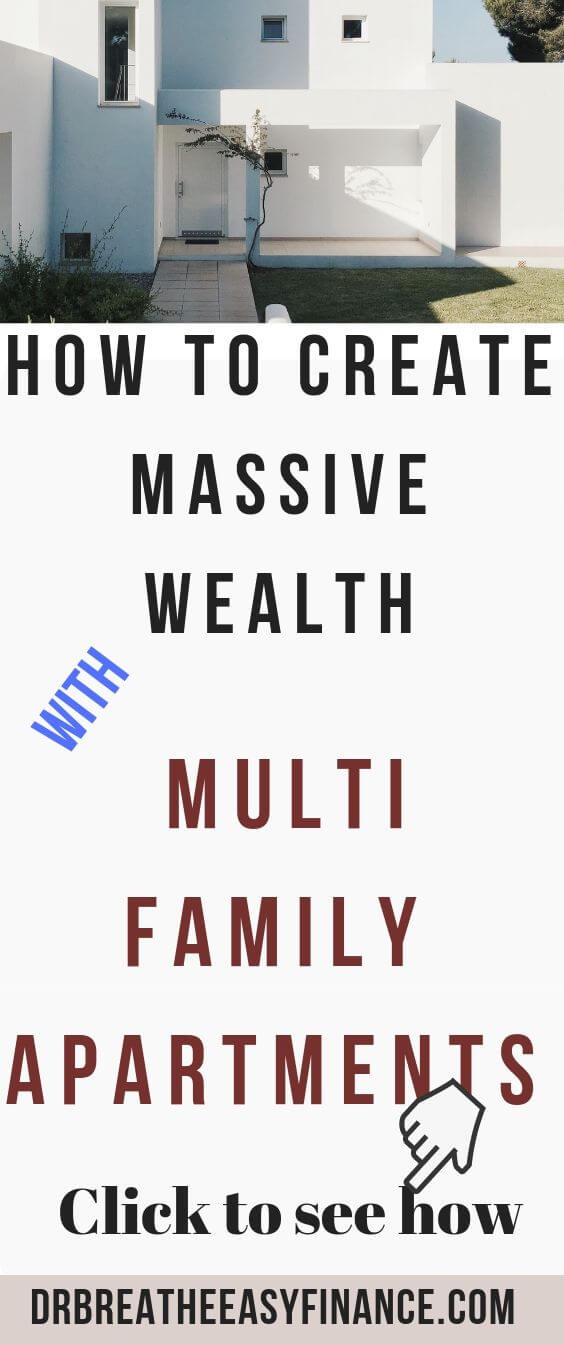Do you want to create massive wealth investing in multi-family apartments via investment real estate?
This article will show you how.
Recently, I have been diversifying my portfolio with real estate. We are in the process of closing a deal on our 8 plex, which will be our first real property apart from syndications.
We also published a guest article on 5 reasons physicians should invest in real estate. In the article, we discussed all the awesome benefits of real estate investing, from tax to performance.
Most people believe the best way to build wealth in real estate is to buy a REIT (real estate investment trust), which you can easily buy on the stock market.
You can also buy a non traded REIT like Diversyfund in which Dr. Breathe Easy invested 50 K of his own money.
And there’s nothing wrong with investing in the stock market, or, buying a REIT for that matter, but, the serious wealth, the kind of money that propels you into the top 1%, is made by those individuals who understand the fundamentals of how to strategically value, buy, upgrade, and sell their own properties.
According to this Forbes magazine article, “How the World’s Billionaires Got So Rich,” real estate and business ownership are at the top of the list.
According to this Forbes magazine article, “How the World’s Billionaires Got So Rich,” real estate and business ownership are at the top of the list. Share on X
And that’s what I am going to explain in this post. Fortunately, you don’t need to be a real estate guru to buy your first property, I will show you, step-by-step:
– how investment real estate is valued, and specifically multi-family apartments
– examples of how to make a return on your investment
– how I made a 344% return in two months
And then I’ll walk you through an example of a property that I am considering, where I stand to make over $4.5 million profit within three years.
I wrote this post with the beginner investor in mind. The things I write about are things I wish someone had explained to me before I started down my real estate path over ten years ago.

Table of Contents
How to Create Massive Wealth By Investing In Multi-Family Apartments.
First, I want to share with you a simple concept you need to understand before you begin the hunt for your first investment property.
At the heart of investment real estate is a concept called the capitalization rate, otherwise known as the CAP rate.
What is the CAP rate?
I’m going to spend some time reviewing this, as it’s important you understand how it impacts your investment and returns.
The CAP rate is the building’s profit (before taxes and building depreciation) divided by the purchase price of the building.
You can check out this Cap Rate article on a more detailed explanation and calculation.
Let me illustrate, first with the formula and then with an example:
CAP Rate = Net Operating Income (NOI) ÷ Building Value (BV)
Let’s say there’s a building on the market that’s selling for $1 million. Let’s assume that the building is netting $100,000 (after expenses like hydro, maintenance, and building management).
The very simplified income statement looks like this:
Revenue = $175,000
Expenses (maintenance, utilities, management) = $75,000
Net Operating Income (NOI) = $100,000
In the above example, this building’s CAP rate = $100,000 ÷ $1 million= 10%.
Why Is the CAP Rate Number So Important?
All commercial real estate properties, multi-family apartments included, trade on their CAP rate. This is the first number a discerning buyer looks at when evaluating a building.
CAP rates vary from city to city and, even then, vary within pockets of a city.
It’s likely that a building in one section of a city has a CAP rate of 5% and then a few blocks over, perhaps in a less desirable area, has a higher CAP rate of 8%.
The less desirable the area, the less the building is worth and, hence, the higher the CAP rate.
It’s not that dissimilar from how a stock’s PE ratio works. Stocks of similar companies and industries have a similar PE ratio. If there’s a variance, there’s almost always a reason.
The same holds true with CAP rates.

Now, imagine a scenario where a building on 123 Main Street with a net profit of $100,000 just sold for a 5% CAP rate, and the building next door at 125 Main Street (which is identical in size, apartments, and every respect other than the rent rates and income) has just been put on the market
Value of 123 Main Street
Let’s review some basic math and solve for the value of the building (BV).
The profit of the building at 123 Main Street, which just sold for a 5% CAP rate, is $100,000.
Remember, the formula is CAP Rate = Income ÷ Building Value.
5% = $100,000 ÷ BV
In this case, BV = $2,000,000.
Now, the building owner at 125 Main Street is going to put their building on the market.
Remember what I explained earlier: buildings are sold based on CAP rate. So the building at 125 Main Street will likely sell at a similar CAP rate, but in this case, let’s imagine the income at 125 Main Street is $120,000.
Value of 125 Main Street
Using the same math as above, let’s solve for BV:
5% = $120,000 ÷ BV
BV = $2,400,000
Notice that the value between the two buildings is $400,000, even though they are identical in every way other than the $20,000 yearly difference in the net operating income.
In the above example, for every extra dollar, you’re able to raise rents or lower expenses, the net operating income increased by $1. At a 5% CAP rate, every extra dollar in NOI increases the value of the building by $20.
Now that you’re a real estate guru and understand the math and CAP rate, I want to illustrate how to create wealth, but I want to illustrate with a story first.
How I Made a 344% Return in 2 Months Investing in Multi-Family Apartments
I got a call in 2014 from my insurance company about a 21-unit building I own. The insurance company no longer wanted to insure the property unless we provided a written guarantee that there was no knob and tube wiring in the building.
As an aside, knob and tube is an older type of electrical wiring that was used until the late 1930s. Given the increased age of the wiring and higher probability of electrical and fire problems, many insurance companies are reluctant to insure buildings with this older style of electrical cable because of a perceived increase in risk.
The insurance company gave me only two months to comply. After this, I had to sign an affidavit confirming there was no knob and tube in the building, otherwise, I had to find a new insurance company.
Fortunately, only two of the units had knob and tube.
Unfortunately, both units were occupied by very long-term (30+ years) tenants, and their rents were well below market because of rent control.
It was only going to cost a few thousand dollars to replace the wiring, repatch all the holes, and clean up the unit. But I saw an opportunity to completely gut the units and significantly raise rents. The problem with rent control, though, is that you can’t just kick out a tenant.
My Big Return
The tenants in the two units were paying approximately $900 per month each in rent. The going rate for a renovated unit in the same building at the time was approximately $1,500 per month, a difference of $600 per month – $7,200 per unit per year extra.
I couldn’t kick the tenants out. I had the option of asking each to vacate for two months while I redid the electrical.
Once completed, because of rent control, I would have to give them their units back at the same rent. There was a negative return on my dollar.
In the end, I paid each tenant approximately $5,000 to vacate their units. I then spent approximately $40,000 in upgrade costs per unit and rerented the units for $1,500 each per month.
When we were done renovating, the units were gorgeous.
Let’s look at the math: $45,000 in upgrades ÷ $7,200 per year in rent increase = 6.25 years until payback.
The 6.25-year return on my initial investment isn’t bad, but that’s not where the big returns come from.
This particular building has a CAP rate of 3.5%. I increased the rents by $7,200 per year per unit. This translates to an increase in the value of the building of $205,000.
3.5% = $7,200 ÷ BV
BV = $205,000
Between the two units, I spent $90,000 in upgrade costs and increased the valuation of the building by more than $400,000. That’s a 344% return on investment, in just two months!
If I had put the building on the market two days after the units were rented, the new buyer would calculate the building’s value based on the new rent roll. (Now, given that I have a long-term buy-and-hold strategy, I held the building.)
But I have another interesting example of how I intend to make over a 100% return in three years on my invested dollar investing in multi-family apartments.
How to Make 110% Return, or $4.7 Million, in 3 Years
As I mentioned earlier, the CAP rates vary by city to city, and even within areas in a city.
As an example, according to the 2018 CBRE North American research report, the average CAP rate for a multifamily Class A building for most North American cities is between 3% and 5.5%.
A few example CAP rates from different North American cities for Multi-Family Apartments
Toronto = 3% to 3.75%
Boston = 3.75% to 4.75%
San Francisco = 3.75% to 4.25%
Atlanta = 4.25% to 5%
St Louis = 5.5% to 5.75%

I am currently considering an offer on a 32-unit apartment building. The listed asking price of the building is $5.65 million, with a stated CAP rate of 3.6%. Normally, I wouldn’t be interested in purchasing a building with such a low CAP rate, but in this particular case, the rents are well below market, and given the illustration of what I explained above with the knob and tube example, there’s the potential to make over $4 million inside 3 years.
The current financials of the building are as follows:
CAP Rate = $203,541 (NOI) ÷ $5,650,000 (BV; asking price) = 3.6%
Assuming we keep the CAP rate constant at 3.6%, every additional dollar in NOI will result in an increased value of the building of $27.78 ($1 ÷ 3.6%).
I estimate that if I spend $1,664,000 in upgrade costs on the building, I can increase the rents by approximately $17,250 per month.
I estimate that I can gut all the units and replace the tenants inside three years. That improves the value of the building, based on a constant 3.6% CAP rate, to approximately $11.4 million.
There’s clearly a much longer story, which I am not going to address at length here. You can read the full background, along with all the numbers, in this blog post: “Here’s How to Buy an Apartment Building and Make a Whopping 110% in Three Years.”
For all of you complaining that CAP rates are too low, the irony is this: if you’re looking to buy, renovate, and raise the rents, then a lower CAP rate is better.
I have been buying investment real estate for many years, so I have a decent sense of how to spot an opportunity and take advantage of CAP rates. I also have more dollars available to invest into a project.
However, the math and mechanics work the same whether you are buying a 4-plex in St Louis for $400,000 or a 35-plex in San Francisco for $8,000,000.
On a much larger scale, the above is an example of how REITs make money with their projects and how they can buy a property in what seems like an overinflated market and still make millions in return on their invested dollar.
They understand how and where to spot an opportunity and invest their capital.
Enter the Entrepreneur and Real Estate
Are you running a profitable business?
If so, then have you ever wondered how to appropriately invest your profits?
Perhaps you’ve spoken with an investment advisor?
Most financial advisors will look at the amount of cash you have available to invest, check the optimal investment strategy and investment horizon for someone your age, come up with a percentage of stocks and bonds based on your available cash, and then design a supposedly “perfect” asset allocation model for you.
There’s just one problem: that conventional asset allocation model doesn’t work for entrepreneurs.
Your investment and cash requirements are different from the regular investor. You already have a large percentage of your wealth tied up in your business, which is equity.
A downturn in the market will result in not only a downturn in your stock portfolio. If the economy enters a recession, there’s a good chance your business will be in need of extra cash.
Most financial advisors simply don’t understand that. They also fail to take an appropriate approach to asset allocation.
Entrepreneurs must understand how to make risk-appropriate decisions when it comes to both investing and their businesses overall.
As a business owner, when you invest in yourself and your business, you take control of the outcome. You also maintain control by finding your own opportunities and capitalizing on them.
With careful diligence, planning, research, and education, you can influence the outcome of your investments without having to rely on the stock market. That’s where, to a great extent, real estate comes into play.
So what is an appropriate asset allocation for an entrepreneur?
I have a three-bucket investment strategy approach that I designed and used for over 30 years. It’s produced a 30% compounded year-on-year return since 1991, which is when I started my business.
Yes, 30% Is a Large Number
Much of that growth was a result of three things:
– my business doing well and producing healthy dividends year after year
– the successful sale of my business to private equity in 2017
– strategically investing in real estate (the way I describe above with multi-family apartments), the capital appreciation of the real estate, and then the ensuing profits that the buildings produce year after year
Very little of the growth was from the stock market.
My investment allocation strategy, in a quick nutshell, is to divide your assets into three equal buckets.
Cash in bucket one. Real estate in bucket two. And the value of your business in bucket three.
My investment allocation strategy is time-tested: 2,000 years old, in fact. It’s not one I created, of course, but a strategy I followed and continue to follow to this day.
I write extensively about this strategy in my book, The Kickass Entrepreneur’s Guide to Investing, which was number one on Amazon business and nonfiction for quite a few weeks during the summer of 2018. You can download a free copy from the above link.
Real estate should be part of your overall asset allocation strategy. You definitely don’t want all of your eggs in one basket, but with proper diversification across a set of somewhat uncorrelated asset classes, you, too, can create massive wealth through real estate. And in case you’re wondering, what net worth makes you rich? The average net worth to make it into the top 1% and how to get there, you can read this post.
Hopefully, you’re now feeling like a real estate guru! Good luck with your first investment.
This post originally appeared on The Money Mix and has been republished with Permission.








Leave a Reply